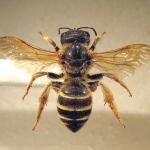With a body length of up to 20 mm in both sexes this is an enormous halictid and one of the largest species worldwide. As such, it can be readily identified in that part of the British Isles where it occurs.
In the British Isles this species is known only from Guernsey and Sark in the Channel Islands, although it only colonised there quite recently; the first record being from Guernsey on 2nd July 1997 and on Sark in September 2006 (the late C David, pers. comm.).
The world range of this bee is Trans-Palaearctic, extending from Fennoscandia to Iberia, east to China (Ascher & Pickering, 2012). It is also known from North Africa (Morocco).
The Channel Islands are, for a number of reasons, excluded from the geographical coverage of the British Red Data book (Shirt, 1987) and the subsequent review (Falk, 1991).
In the Channel Islands, the species has been encountered on coastal grassland (C David, pers. comm.). According to Pesenko et al. (2000) the species favours warm dry habitats, such as parks, roadsides, quarries etc. as nesting sites.
Females are active from April to August (occasionally as late as October); males can be found from July to September or October.
The author of this profile has observed females nesting in a very extensive aggregation on level sandy soil in an open site in southern Spain (Andalusia). The large, open nest burrows were particularly obvious. Several females may nest co-operatively (Pesenko et al., 2000). This is a solitary species as only one generation is reared in a season (this consists of reproductive females (gynes) and males; there is no worker caste). Cells are built in clusters of between four and 20 and, when completed, are within a cavity, the cells being supported by several pillars of soil. A nest may contain several such clusters, each cavity opening into the main nest burrow.
The only flower record for the Channel Islands is spear thistle (C David, pers. comm.).
Several authors cite Sphecodes gibbus (Linnaeus) as a cleptoparasite of this bee (for example, Amiet et al., 2001).
2019


